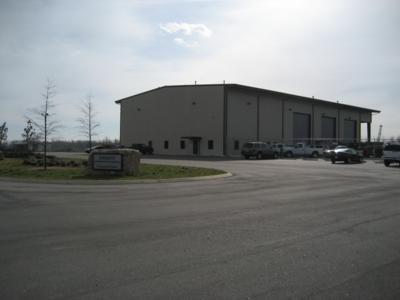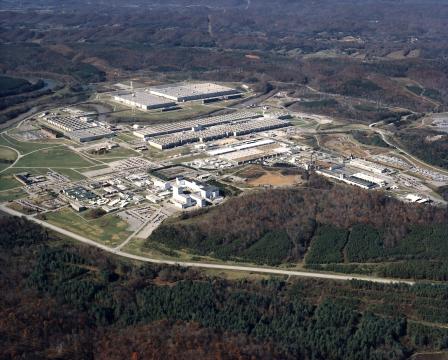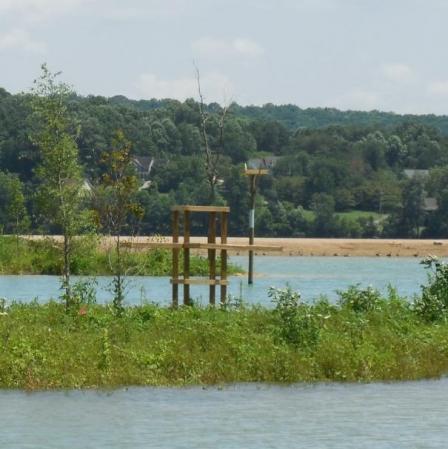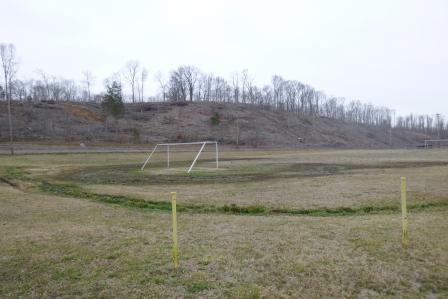Superfund Sites in Reuse in Tennessee
If you are having trouble viewing the map in your browser, click the 'View larger map' link below
American Creosote Works, Inc. (Jackson Plant)
 American Creosote Works, Inc. (Jackson Plant)The 60-acre American Creosote Works, Inc. (Jackson Plant) Superfund site is located southwest of Jackson, Tennessee. A wood-treating facility operated at the site from the early 1930s until late 1981. The facility discharged untreated process wastewater directly into the South Fork of the Forked Deer River. Process water and sludge stored in on-site pits often overflowed into the main process area and the river during heavy rains and flooding. In 1983, an EPA investigation found that site activities contaminated soil, sediment, surface water and shallow groundwater. In 1986, EPA placed the site on the Superfund program’s National Priorities List (NPL). EPA conducted cleanup activities at the site between 1986 and 1996. Cleanup activities included the treatment and disposal of wastewater, and treatment and burial of sludge under a clay cap. Cleanup also included disposing of tanked liquid waste and sludge, demolishing contaminated buildings and equipment, and removing and treating contaminated soil. Land and groundwater use restrictions are in place. Site owners Dement Construction and Jackson Energy Authority use the property as an equipment storage facility. Between 2006 and 2007, Dement Construction placed fill material over the cap to upgrade the site for use as an equipment yard. Dement Construction also constructed an office building, and maintenance and storage shed on site.
American Creosote Works, Inc. (Jackson Plant)The 60-acre American Creosote Works, Inc. (Jackson Plant) Superfund site is located southwest of Jackson, Tennessee. A wood-treating facility operated at the site from the early 1930s until late 1981. The facility discharged untreated process wastewater directly into the South Fork of the Forked Deer River. Process water and sludge stored in on-site pits often overflowed into the main process area and the river during heavy rains and flooding. In 1983, an EPA investigation found that site activities contaminated soil, sediment, surface water and shallow groundwater. In 1986, EPA placed the site on the Superfund program’s National Priorities List (NPL). EPA conducted cleanup activities at the site between 1986 and 1996. Cleanup activities included the treatment and disposal of wastewater, and treatment and burial of sludge under a clay cap. Cleanup also included disposing of tanked liquid waste and sludge, demolishing contaminated buildings and equipment, and removing and treating contaminated soil. Land and groundwater use restrictions are in place. Site owners Dement Construction and Jackson Energy Authority use the property as an equipment storage facility. Between 2006 and 2007, Dement Construction placed fill material over the cap to upgrade the site for use as an equipment yard. Dement Construction also constructed an office building, and maintenance and storage shed on site.
For more information:
Arlington Blending & Packaging
The 2.3-acre Arlington Blending & Packaging Superfund site is located in the town of Arlington, Tennessee. A pesticide formulation and packaging plant operated at the site from 1971 to 1978. Site operations and pesticide spills and leaks contaminated soil and groundwater. In 1987, EPA added the site to the Superfund program’s National Priorities List (NPL). Cleanup activities included disposal of contaminated equipment and waste chemicals, removal and treatment of contaminated soil, and monitoring of groundwater and surface water. In 2004, EPA issued a Ready for Reuse (RfR) determination for the site. EPA designed the RfR determination to reassure Arlington residents and officials of the site’s safety for specific types of reuse. EPA Region 4 worked with the Town of Arlington to develop remedy-friendly plans for a neighborhood park at the site. EPA’s participation in the planning process made sure that playground construction activities did not affect the site’s remedy. Mary Alice Park, named for the nearby subdivision, opened with a ribbon-cutting ceremony on November 15, 2006. The park is now open to residents of the surrounding communities. The park includes a playground, field space, walking and biking trails, and exercise stations. It also includes a half-court basketball court and signs that explain the history of the park and celebrate its successful redevelopment. Franklin Hill, Director of EPA’s Region 4, Superfund Division, presented EPA's "Excellence in Site Reuse" award to the Town of Arlington on June 17, 2009. The site’s redevelopment enhanced EPA's selected remedy and revitalized the property and the surrounding neighborhood.
For more information:
- Arlington Blending & Packaging Ready for Reuse Determination (2004) (PDF) (23 pp, 579 K, About PDF)
- Excellence in Site Reuse Award Presented to the Town of Arlington, Tennessee
- Video: Overcoming Barriers: Mary Alice Park, Arlington, Tennessee Exit
- Superfund Site Profile Page
Carrier Air Conditioning Co.
 Carrier Air Conditioning Co.The 135-acre Carrier Air Conditioning Co. Superfund site is located in Collierville, Tennessee. Starting in 1967, Carrier Air Conditioning Co. (Carrier) manufactured air conditioning units on the property. The manufacturing process used solvents to degrease metal parts. The company disposed of wastewater containing solvents and metals in a lagoon on the property. In addition, two solvent spills occurred at the main plant building on site in 1979 and 1985. State investigations in the mid-1980s found that site activities contaminated soil and groundwater. EPA added the site to the Superfund program’s National Priorities List (NPL) in 1990. Cleanup activities included treating contaminated groundwater and soil, and zoning the property for industrial use. Carrier, under EPA guidance, completed construction of the groundwater treatment system in 1995. Carrier continues to operate a manufacturing plant at the site.
Carrier Air Conditioning Co.The 135-acre Carrier Air Conditioning Co. Superfund site is located in Collierville, Tennessee. Starting in 1967, Carrier Air Conditioning Co. (Carrier) manufactured air conditioning units on the property. The manufacturing process used solvents to degrease metal parts. The company disposed of wastewater containing solvents and metals in a lagoon on the property. In addition, two solvent spills occurred at the main plant building on site in 1979 and 1985. State investigations in the mid-1980s found that site activities contaminated soil and groundwater. EPA added the site to the Superfund program’s National Priorities List (NPL) in 1990. Cleanup activities included treating contaminated groundwater and soil, and zoning the property for industrial use. Carrier, under EPA guidance, completed construction of the groundwater treatment system in 1995. Carrier continues to operate a manufacturing plant at the site.
For more information:
Copper Basin Mining District
The Copper Basin Mining District site in southeast Tennessee and northern Georgia includes a 26-mile stretch of the Ocoee River and parts of the North Potato Creek and Davis Mill Creek watersheds. From the late 1800s to the 1980s, mining, processing, chemical manufacturing and waste disposal resulted in the erosion and transportation of soil and wastes from the watersheds into the Ocoee River. Historic mining and mineral processing operations on site left over 30 square miles of land barren of vegetation. Cleanup is ongoing; activities so far have included waste and structure removal, surface capping, stream and wildlife restoration, and water collection and treatment. Since 2002, site stakeholders have revegetated 385 acres in the North Potato Creek, 17 acres in the Davis Mill Creek watershed, as well as other areas of the site. As part of the revegetation effort, stakeholders planted over 400,000 trees. Seed mixes used in restoration included over 20 varieties of native plants and wildflowers. Revegetating on-site land with native species provides much-needed habitat for pollinators.
For more information:
ICG Iselin Railroad Yard
The 80-acre ICG Iselin Railroad Yard Superfund site is located in Jackson, Tennessee. In 1906, the Mobile & Ohio Railroad Company operated a rail yard with train engine repair and refueling services on site. In 1972, the company became the Illinois Central Gulf Railroad Company (ICG). The firm continued operations until 1986, when ICG sold the site to Norfolk-Southern. The Williams Steel Company purchased part of the site to operate a steel fabrication facility in 1989. In 1990 and 1991, the Tennessee Division of Remediation (TDOR) found contaminated soil and groundwater. Further investigations by TDOR and EPA determined that improper handling of storage tanks, fueling stations and disposal areas on site resulted in lead contamination of soil and groundwater. EPA added the site to the Superfund program’s National Priorities List (NPL) in 1994. In 1998, state and federal agencies worked together to remove and replace lead-contaminated soil on site. Grass now grows on the cleaned up areas. EPA also restricts residential groundwater use. Current site zoning allows for industrial and commercial use. EPA removed the site from the NPL in 2002. The William Steel Company continues to operate a steel fabrication facility on site. The Norfolk-Southern property remains in use as a railroad yard.
For more information:
National Fireworks
The National Fireworks Superfund site occupies 260 acres east of Memphis in Cordova, Tennessee. From 1941 to 1945, National Fireworks manufactured various munitions on site. Munitions included flares, grenades, incendiary bombs, as well as rounds of ammunition for the Army and Navy. Also located on the property are areas formerly used for testing flares, a former burn pit used to dispose of building materials, and areas formerly used for disposal of various chemical wastes. A site inspection conducted in 2001, and an expanded site inspection in 2004, discovered several contaminants in site soil and groundwater. Contamination is a result of historical site operations. The site is not listed on the Superfund program’s National Priorities List (NPL). However, the site is being managed as a Superfund Alternative Site. This approach uses the same investigation and cleanup process and standards used for NPL sites. Studies to determine the nature and extent of contamination, and to determine suitable cleanup options, are currently underway. Today, the former National Fireworks site is an active industrial park, strengthening area infrastructure and providing employment to the local community.
For more information:
Oak Ridge Reservation (USDOE)
 Oak Ridge Reservation (USDOE)The U S Department of Energy (DOE) Oak Ridge Reservation (ORR) Reindustrialization Program is in the process of transforming portions of the Reservation into a business center for private sector industries. The DOE ORR property boundary contains three main, but geographically separate, facilities: The East Tennessee Technology Park (ETTP) (formerly known as the K-25 Site or the Oak Ridge Gaseous Diffusion Plant); the Y-12 National Security Complex (formerly known as the Y-12 Plant) and the Oak Ridge National Laboratory (ORNL) (formerly known as the X-10 Site). These three large industrial production facilities were constructed as part of the World War II-era Manhattan Project. A significant portion of the DOE ORR is undeveloped forested land. Decades of site operations resulted in wide spread area contamination, and to EPA’s placement of the site on the National Priorities List (NPL) in 1989. To date, the primary environmental cleanup and redevelopment activities have occurred at the ETTP, where more than 10 private companies have utilized over 1,000 of 2,200 acres for reuse. The businesses are reusing the ETTP site’s industrial-scale infrastructure, buildings and advanced telecommunications capabilities. Additionally, the facility’s proximity to major highways, as well as access to rail and river transportation further draws private industry to this location. The approximate 600 acre Y-12 National Security Complex at the ORR maintains a crucial current and future mission for national security. Limited portions (approximately 18 acres) of this industrial complex have become available for private industry reuse. However, no further re-development of this complex is anticipated in the near future. The approximate 500-acre ORNL complex, a multi-program international research facility, has provided a smaller area (2 acres) for redevelopment, and no further property transfers are envisioned at ORNL in the foreseeable future. Finally, DOE has placed nearly 3,000 of the Reservation’s 35,000 acres into a conservation easement. The easement area now includes a Wildlife Management Area and a State Natural Area.
Oak Ridge Reservation (USDOE)The U S Department of Energy (DOE) Oak Ridge Reservation (ORR) Reindustrialization Program is in the process of transforming portions of the Reservation into a business center for private sector industries. The DOE ORR property boundary contains three main, but geographically separate, facilities: The East Tennessee Technology Park (ETTP) (formerly known as the K-25 Site or the Oak Ridge Gaseous Diffusion Plant); the Y-12 National Security Complex (formerly known as the Y-12 Plant) and the Oak Ridge National Laboratory (ORNL) (formerly known as the X-10 Site). These three large industrial production facilities were constructed as part of the World War II-era Manhattan Project. A significant portion of the DOE ORR is undeveloped forested land. Decades of site operations resulted in wide spread area contamination, and to EPA’s placement of the site on the National Priorities List (NPL) in 1989. To date, the primary environmental cleanup and redevelopment activities have occurred at the ETTP, where more than 10 private companies have utilized over 1,000 of 2,200 acres for reuse. The businesses are reusing the ETTP site’s industrial-scale infrastructure, buildings and advanced telecommunications capabilities. Additionally, the facility’s proximity to major highways, as well as access to rail and river transportation further draws private industry to this location. The approximate 600 acre Y-12 National Security Complex at the ORR maintains a crucial current and future mission for national security. Limited portions (approximately 18 acres) of this industrial complex have become available for private industry reuse. However, no further re-development of this complex is anticipated in the near future. The approximate 500-acre ORNL complex, a multi-program international research facility, has provided a smaller area (2 acres) for redevelopment, and no further property transfers are envisioned at ORNL in the foreseeable future. Finally, DOE has placed nearly 3,000 of the Reservation’s 35,000 acres into a conservation easement. The easement area now includes a Wildlife Management Area and a State Natural Area.
For more information:
Smalley-Piper
The 9-acre Smalley-Piper Superfund site is located in Collierville, Tennessee. A manufacturing facility operated on site, producing farm tools and battery casings in the 1960s and 1970s. Wastewater discharged to a pond on site and into surface water drainage ditches, resulted in soil and groundwater contamination. Groundwater contamination affected the Memphis Aquifer, the primary source of drinking water in the area and posed a potential human health risk. Groundwater contamination also affected two of Collierville’s public drinking water supply wells, which the town no longer uses. In 2005, EPA placed the site on the Superfund program’s National Priorities List (NPL). In 2008, EPA issued a cleanup plan for the site. Planned cleanup activities included removal, treatment and disposal of contaminated soil and groundwater. EPA completed the soil cleanup in 2012 and constructed a groundwater treatment system in 2015. The new system should be in operation by late 2015. EPA currently leads site activities in cooperation with the Tennessee Department of Environment and Conservation. Groundwater monitoring at the site is ongoing. A self-storage facility currently operates on a portion of the site.
For more information:
TVA Kingston Fossil Plant Fly Ash
 TVA Kingston Fossil Plant Fly AshSince 1955, the Tennessee Valley Authority (TVA) has operated a power plant in Kingston, Tennessee. In December 2008, a containment dike for coal fly ash at the facility failed; the initial release of material – about 5.4 million cubic yards – created a wave of water and ash that choked the adjacent Emory River, disrupted electrical power, ruptured a natural gas line, covered a railway and local roadways, and necessitated the evacuation of a nearby neighborhood. EPA, TVA, the Tennessee Department of Environment and Conservation (TDEC), and other state and local agencies responded immediately. The cleanup’s overall objectives were to ensure that it was protective of public health and the environment, employed sound science, and took place as quickly and safely as possible. After removal and disposal of contaminated material, extensive ecological restoration using native species and pollinator-friendly plants followed. In May 2014, Lakeshore Park opened on site. The 32-acre park includes walking trails, a boat ramp and dock, fishing piers, canoe launches, restroom facilities and a pedestrian bridge. In addition to cleaning up the site, TVA has also made important community contributions. TVA provided $43 million in funding to the Roane County Economic Development Foundation and invested more than $10 million in recreational and ecological restoration enhancements in the Swan Pond area. In recognition of TVA’s efforts to support cleanup, ecological restoration and community revitalization, EPA Region 4 awarded TVA its Excellence in Site Reuse award in June 2015.
TVA Kingston Fossil Plant Fly AshSince 1955, the Tennessee Valley Authority (TVA) has operated a power plant in Kingston, Tennessee. In December 2008, a containment dike for coal fly ash at the facility failed; the initial release of material – about 5.4 million cubic yards – created a wave of water and ash that choked the adjacent Emory River, disrupted electrical power, ruptured a natural gas line, covered a railway and local roadways, and necessitated the evacuation of a nearby neighborhood. EPA, TVA, the Tennessee Department of Environment and Conservation (TDEC), and other state and local agencies responded immediately. The cleanup’s overall objectives were to ensure that it was protective of public health and the environment, employed sound science, and took place as quickly and safely as possible. After removal and disposal of contaminated material, extensive ecological restoration using native species and pollinator-friendly plants followed. In May 2014, Lakeshore Park opened on site. The 32-acre park includes walking trails, a boat ramp and dock, fishing piers, canoe launches, restroom facilities and a pedestrian bridge. In addition to cleaning up the site, TVA has also made important community contributions. TVA provided $43 million in funding to the Roane County Economic Development Foundation and invested more than $10 million in recreational and ecological restoration enhancements in the Swan Pond area. In recognition of TVA’s efforts to support cleanup, ecological restoration and community revitalization, EPA Region 4 awarded TVA its Excellence in Site Reuse award in June 2015.
For more information:
- News Article: Roane County’s Gupton Wetlands has wading birds galore Exit
- Superfund Site Profile Page
Velsicol Chemical Corp. (Hardeman County)
The 27-acre Velsicol Chemical Corp. Superfund site is located in Toone, Tennessee. The Velsicol Chemical Corporation operated a landfill on the site from 1964 to 1973. Landfill operations resulted in groundwater, soil, solid waste, air and surface water contamination from pesticide manufacturing wastes. EPA placed the site on the Superfund program’s National Priorities List (NPL) in 1983. Cleanup activities include long-term monitoring of groundwater, surface water, fish tissue and air. Long-term remedies for contamination source control include landfill upgrades, capping and monitoring. A soil vapor extraction (SVE) pilot study conducted in 2008 determined that SVE was a suitable cleanup option for contamination source control. In 2012, EPA amended the Record of Decision (ROD) to include SVE and a landfill cap extension with drainage improvements. Velsicol Chemical Corporation, the site’s potentially responsible party (PRP), redeveloped 3 acres of the site as a pollinator habitat in 2016.
For more information:
Wrigley Charcoal Plant
 Wrigley Charcoal PlantThe Wrigley Charcoal Plant Superfund site is located in Wrigley, Tennessee. The 330-acre site includes several areas of concern. From 1881 to 1966, a 35-acre area of the site supported industrial activities. Manufacturers disposed of wastewater in nearby fields, ponds and Mill Creek until the mid-1940s. In 1978, the Pinewood Manufacturing Company, leased the site. EPA added the site to the Superfund program’s National Priorities List (NPL) in 1989. Interim cleanup activities included excavating waste pits and treating contaminated soils. EPA connected at-risk residents to the city water supply and restricted groundwater use. A focused remedial investigation and feasibility study to characterize additional areas of concern is ongoing. A removal action to address asbestos contamination at the site is also underway. There is an athletic field on site owned by the Hickman County Parks and Recreation Department. A residential community occupies the Clark Hollow portion of the site.
Wrigley Charcoal PlantThe Wrigley Charcoal Plant Superfund site is located in Wrigley, Tennessee. The 330-acre site includes several areas of concern. From 1881 to 1966, a 35-acre area of the site supported industrial activities. Manufacturers disposed of wastewater in nearby fields, ponds and Mill Creek until the mid-1940s. In 1978, the Pinewood Manufacturing Company, leased the site. EPA added the site to the Superfund program’s National Priorities List (NPL) in 1989. Interim cleanup activities included excavating waste pits and treating contaminated soils. EPA connected at-risk residents to the city water supply and restricted groundwater use. A focused remedial investigation and feasibility study to characterize additional areas of concern is ongoing. A removal action to address asbestos contamination at the site is also underway. There is an athletic field on site owned by the Hickman County Parks and Recreation Department. A residential community occupies the Clark Hollow portion of the site.
For more information:
